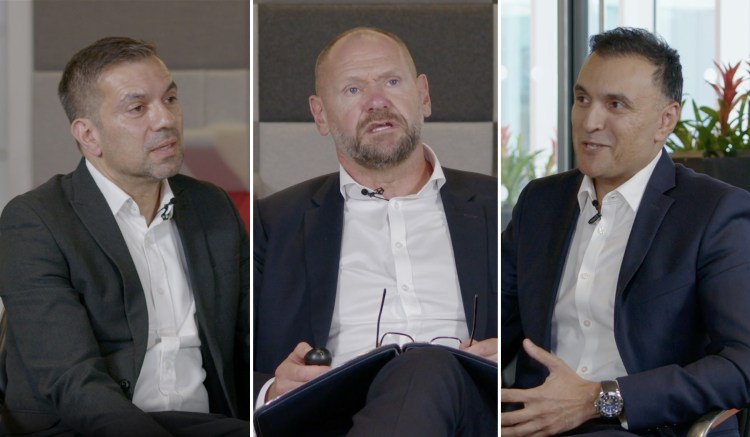On September 23, 2024, we welcomed compliance and surveillance experts Hammad Hanif and Darren Sirr to our London office for our “Social Media: To Ban or Not to Ban” webinar. Chaired by Rob Mason, our Director of Regulatory Intelligence, the panel discussed the hidden risks of social media for communications compliance, the growing use of finfluencers, and how approaches including communications capture and surveillance can help manage the potential future risks of social media.
We’ve summarized some of the key insights from the session below, but to watch the webinar in full – including audience Q&A – click here.
Panel

Hammad Hanif
Head of Electronic & Voice Communications Surveillance & QA, Lloyds Banking Group

Darren Sirr
Global Head of Surveillance, BNY Mellon Markets

Rob Mason
Director of Regulatory Intelligence, Global Relay
Getting personal
A key point of discussion was personal social media accounts used by those working in financial services, and how firms must navigate their use when they raise challenging questions about where they need to be monitored or captured for business purposes. Sirr questioned that, where employees had an obvious link to a workplace or employer on a private profile, “how could a post on a personal account be seen as business content? Should it be recorded?”
Sirr also identified that there are challenges in establishing how – and when – to record messages including emojis, or messages on ‘ephemeral’ platforms. He identified that the regulatory focus on recordkeeping fines has set a precedent of staff handing over mobile devices for monitoring, and that “now a lot of employers are looking at their contracts” to identify what information employees are obliged to share with them – something that will be more challenging in some jurisdictions. “Firms might insist we hand over personal accounts,” Sirr says, but he questioned how employees can best supply these details.
Hanif explained that there is a “general understanding that people have their activities monitored”, but identified that a major challenge comes in the form of employee ‘buy-in’ around personal socials needing to be monitored. He was clear that “firms need to be very clear on their expectations” when personal channels might need to be captured, but that it cuts both ways, as “employees need to understand the risks these can pose” and “monitoring personal social media handles will protect the firm.” The question here for Hanif is, “where does it stop?” and that it may cause issues where an employee’s “personal views aren’t in line with those of the organization.” For Hanif, “policies, procedures, and attestations” are vital in helping firms navigate these challenges.
“How do we solve this Kim Kardashian problem?” – Hammad Hanif
Hanif’s question relates to the well-publicized 2022 case that saw the Securities and Exchange Commission (SEC) fine Kim Kardashian $1.26 million for promoting a crypto asset security on her social media profiles without disclosing that she received payment to promote the scheme. Hanif raised this and other recent examples of finfluencer marketing as a fast-evolving area of social media-based risk for firms.
“What’s driving this is a distortion of general public view between social media and finfluencers,” according to Hanif, as the public are liable to “disregard some of the basics of making investment decisions when finfluencers are on board.” He cautioned that the public “need to stop believing in what finfluencers are saying” and “take on board the fact that finfluencers are being paid to advertise products.” The issue at hand is that “finfluencers don’t have any regulatory responsibility to their followers,” and that we can expect to see regulators “clamping down hard” on the role of finfluencers in marketing financial services. While in Kim Kardashians case, Hanif questioned whether a necessary disclosure would have prevented her followers from investing, he believes that “firms paying influencers need to be hit hard” by regulators where issues occur to help the public – and firms – understand the real risks.
Marketing rules for marketing risks
Stepping back from finfluencers specifically and looking at social media marketing risks more broadly, Hanif believes that “labeling it as marketing and advertising risk doesn’t do it enough justice,” and that regulators are “expecting a bit more” from firms working to manage these risks. He also identifies that social media companies themselves “should be taking more accountability for their part in providing a platform for misadvertising to take place.”
Sirr outlined that “disclosure rules are really important to consider” for firms leveraging LinkedIn as a marketing and promotional tool, and that messages – especially those from personal accounts – should be run through “lexicons and surveillance” tools in order to ensure they abide by marketing and cultural expectations. Sirr counseled that, while firms are getting to grips with social media compliance on platforms that are currently being widely utilized, LinkedIn is for “an older generation,” and firms need to be mindful that younger employees may be using “platforms we might not have heard yet” when assessing their risk posture.
Fake news, real impacts
Both Sirr and Hanif were clear on one of the most prevalent risks social media can pose to firms – misinformation and the impacts of ‘fake news’.
Hanif related that some are “using social media to base trading decisions on, potentially illegally.” Traders see what they believe to be news on social media, and make trading decisions based on this information, without understanding that the information is false. By traders “reacting to what’s happening” and driving stock prices up or down, firms – and the wider markets – can find themselves being manipulated by fake news. Sirr identified “hoaxes of people allegedly promoting a scheme and then finding out it’s a hoax later on,” by which point it’s “too late” and both traders and the public may have been influenced by the misinformation.
Sirr related that some traders are “looking to social media as part of their price monitoring,” such as information shared on Reddit, and used the example of French regulator AMF fining Bloomberg $5.5 million for publishing a hoax press release that caused market movements as an example of how even trustworthy news sources can be misled, and mislead others in turn, via fake news. Hanif outlined that individuals see social media news feeds as “no different to Bloomberg or Reuters” when it comes to ingesting and trusting information that they base decision making on, and that it can be very difficult to determine fake news from legitimate stories. He cautioned that “you’re too late by the time something has happened, even if you’re monitoring it,” using the example of how a post on X by someone as high profile as Elon Musk can go viral in seconds and cause potential market disruption.
“LinkedIn is just the tip of the iceberg” – Darren Sirr
Looking to the future, both Sirr and Hanif believe we are only just starting to get to grips with the potential risks social media might present to firms. For Hanif, firms need to ensure that they are taking social media risk seriously and acting accordingly, because it is now well enmeshed within financial services: “Social media is here, in the mainstream, and will continue to evolve. [Firms] need to make sure it provides the right benefits, but doesn’t cause more harm than good.”
Sirr believes that firms are “viewing this as the next WhatsApp area” in terms of the potential pace and extent of regulatory enforcement activity we might see. While firms might feel like they have a handle on social media risks because they’ve established compliant use of the most popular channel used for business comms and marketing, Sirr has this to say: “LinkedIn is just the tip of the iceberg.”




